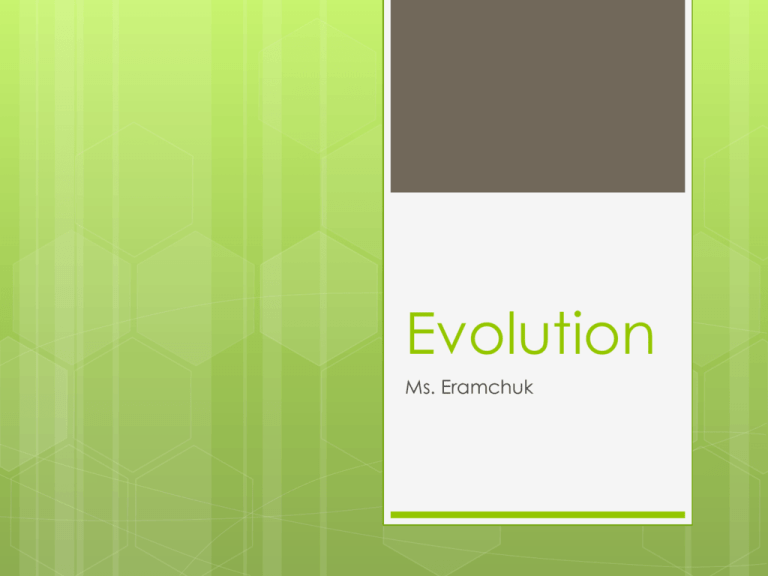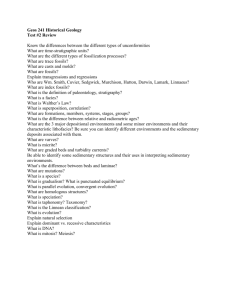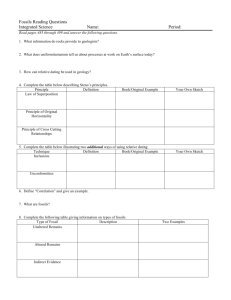Evolution - Ms. Eramchuk's Site!
advertisement

Evolution Ms. Eramchuk Rotational Graffiti Draw –EVOLUTION Write – EVOLUTION Draw – POPULATION Write – POPULATION What do I already know about population/evolution? What is Evolution?? https://www.youtube.com/watch?v=GhH OjC4oxh8 Evolution of the Cellphone 1) 2) 3) 4) Describe the characteristics that evolved over time Are there any traits that “disappeared”? Describe the new traits that appeared. Why is this a good example of evolution? Evolution Evolution refers to the permanent genetic change (change in gene frequencies) in population of individuals across generations Evolution does not refer to changes occurring to individuals within their own lifetimes. Populations evolve, not individuals. Evolution Microevolution – describes the small-scale changes within gene pools over generations Evolution Macroevolution – Describes large scale changes in form, as viewed in the fossil record, involving whole groups of species and genera Evidence for Evolution (Entrance Slip) What are some examples that you can think of that are evidence that evolution has occurred? Please complete (pg.3 of your frame notes). You may complete individually or with a partner Evidence for Evolution Evolutionary theory is now supported by a wealth of observations and experiments. Although biologists do not always agree on the mechanisms by which populations evolve, the fact that evolution has taken place is well documented Hypothesis vs. Theory Scientific Hypothesis: • Proposed explanation for a phenomenon made on the basis of limited evidence as a starting point for further investigation Scientific Theory: Group of verified hypothesis that have been substantiated (proven) through repeated experiments or testing. Theories may change as scientists learn more about the topic Scientific Theory: Scientists use the word ‘theory’ differently than how it is commonly used in the public. Most people use the world ‘theory’ to mean an idea or hunch that someone has, but in science the word ‘theory’ refers to the way we interpret facts. The Recycling Lab Science is built on evidence that can be observed or deduced from the natural world Evidence can be confusing, seemingly conflicting, and apparently random All evidence may not be available The Recycling Lab You will receive several types of “clues” used to develop a hypothesis, scientists use a variety of criteria to compare explanations, selecting the better ones Procedure You will be arranged into groups (3-4) You will be given a bag of recycling from a fictional group of people. Do not look at the recycling until instructed to do so! Remove 4 pieces of recycling and place them on the lab table. Procedure Observe the recycled material. Try to formulate a tentative hypothesis that explains the storyline represented by the recycling. What kinds of questions can you be asking while trying to develop your theory/storyline? Record this theory as your original hypothesis Procedure Select FOUR more pieces of recycling from the bag. Incorporate this new information into your storyline. This is your SECOND TENTATIVE HYPOTHESIS. Record this on your worksheet. Procedure Remove 2 final pieces. Use this new information to formulate a THIRD TENTATIVE HYPOTHESIS. Record this on your worksheet. Do not remove anymore recycling. Scientists never have all of the data they might need to reach the highest level of confidence in their explanations. Procedure Collaborate with another group – share your information Other groups may have different pieces of data (scientists share data and ideas) When instructed, come back together with your group to formulate a FINAL HYPOTHESIS based on all of the available data. Final Hypothesis Attempt to explain the events in the life of the character(s) who recycled the materials. Record this on your worksheet. *Scientific explanations are tentative because we can never be absolutely sure that all of the information about a problem is known and that new information may be discovered later! Discussion Collaboration Limited data Personal bias and experience Edmodo Post – by midnight please do not wait until 11:59. Go to bed. Finish it while you eat your sandwich at lunch. Based on today’s class/ lab experience, has your understanding of a scientific theory changed? Why or why not? Evidence for Evolution Evidence sources: for evolution comes from many Paleontology: The identification, interpretation and dating of fossils gives us some of the most direct evidence of evolution Evidence for Evolution Embryology and evolutionary developmental biology. The study of embryonic development in different organisms and its genetic control The embryos of animals show evidence of similar ancestral developments. Evidence for Evolution Biochemistry: Similarities and differences in the biochemical make-up of organisms can closely parallel similarities and differences in appearance. Molecular genetics: Sequencing of DNA and proteins indicates the degree of relatedness between organisms Types of Fossils The term fossil refers to any parts of impressions of an organism that may survive after its death Fossils are most commonly found in sedimentary rock. What information can we get from the fossils found in sedimentary rock?? Strathcona Park, Vancouver Island, Canada Types of Fossils Mineral-rich hard parts (bones, teeth, shells) may remain as fossils. Sometimes minerals dissolved in water, may seep into tissues and replace the organic matter of the organism. What is this process known as? Interpretation of Fossils The fossil record is an orderly array in which fossils appear in the layers, or strata of sedimentary rocks When organisms are trapped in sediments, they record that moment in time. How are we able to tell the relative age of fossils? Interpretation of Fossils Because younger sediments overly older ones, it is possible to determine the relative age of fossils. This is different than absolute dating, which determines how long ago an event occurred usually through radio-isotope dating (radioactive decay) Based on fossil evidence and radio-isotope dating, the evolutionary history of plants, fungi, bacteria, protists, and non-chordate animals can be compiled Bacteria, protists and fungi have an evolutionary history extending back to the Precambrian. Some invertebrate groups extend back to the Cambrian Period, but land plants only as far back as the Devonian Period. Similarly, the evolutionary history of chordates can be traced back to the Cambrian, but most animal groups are much more recent than this. Timeline Activity: p. 376 Textbook 1 billion = 1000 million 1 000 000 000 = 1 billion 1 000 000 = 1 million






